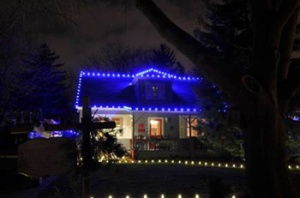Winter has officially arrived, despite a lack of snow to prove its presence. While we struggle through the longest night of the year, Winter Solstice has a brighter side to it—the days are only going to get longer from here.
It should come as no surprise then, that festivals of light are so prevalent at this time of year. We are all looking for a little more sunshine, no matter our religion, ethnic group or cultural beliefs. In North America, the most widely celebrated festival of light is Christmas, but people celebrate other festivals as well, like Diwali, Hanukkah, and Kwanzaa. Let’s embrace the light today and look at how different groups celebrate the return of the light.
Festivals of Light
Christmas –

Christmas is a worldwide celebration of peace, love, faith, gift-giving and the light that unites us all
Christmas is one of the biggest celebrations in the Christian faith. It is celebrated on December 25th—the birthday of Jesus Christ. In traditional tellings, the three wise men visited the new lord king in his humble manger surrounded by shepherds and their flocks, where they bestowed gifts of frankincense, myrrh, and gold.
Gift giving is still a major part of Christmas, whether people celebrate the religious significance or not. Santa Claus and his sack of gifts for all the good girls and boys around the world mingles with traditional Christmas gift giving. Not to mention the exchange of Christmas cards as well.
Other symbols of Christmas include the revered Christmas trees with plenty of lights. Pagan symbols like mistletoe, holly and evergreen boughs mix with nativity scenes and advent calendars. It wouldn’t be Christmas without Christmas carols and the feasts which get prepared throughout households across the world. It is all doused in good cheer and faith in human kindness (not to mention a healthy dose of busyness and stress to get it all done).
Diwali –

“The Rangoli of Lights” by Subharnab Majumdar – originally posted to Flickr as The Rangoli of Lights. Licensed under CC BY 2.0 via Commons.
Diwali is a Hindu celebration and one of their brightest. In fact it is officially known as a festival of lights and celebrates the victory of light over darkness. The light signifies the winning out of knowledge over ignorance, good over evil, and hope over despair. And to celebrate these significant milestones they light up their world; lights get placed inside and outside all homes, businesses, and temples.
The celebrations occur in the Autumn (the date follows the lunar cycle in mid-October into November), and spans a period of five days. In the days leading up to the celebrations, people clean their houses and renovate in preparation. People buy gifts for friends and family and make rangoli (intricate designs made of geometric patterns) to welcome deities into homes. The highlight of Diwali is of course the food and sharing of stories, but the fireworks that punctuate the night sky are always highly anticipated as well. It is a joyous time enjoyed by all and for good reason.
Hanukkah –

Tree of Life menorah – made by Acme Animal
While Hanukkah is not traditionally considered one of Judaism’s highest holidays, its proximity to Christmas has thrust it more so into the limelight. Hanukkah is the Jewish celebration of light and falls anywhere from mid-November to December. It too celebrates the vanquishing of light over darkness, but also purity over adulteration, and spirituality over materialism.
The story behind Hanukkah stemmed from the war between Jews and the Greeks over 21 centuries ago. A small bands of Jews drove the Greeks from Jerusalem, but in the process, the oil for their lamps became contaminated. There was only enough oil to last a day, but miraculously the oil managed to last until new oil could be ritually prepared for their menorah.
Today the lighting of the menorah represents the deliverance from evil. On each of the eight days of Hanukkah, a new candle is lit and prayers are said. People eat foods cooked in oil (like latkes and sufganiot), play games (like dreidel) and exchange gifts (gelt).
Kwanzaa –

Candles are lit in the kinara on each day of Kwanzaa while the 7 principles get discussed; unity, self-determination, collective work, cooperative economics, purpose, creativity, and faith
Kwanzaa is a relatively new celebration of light—it has only been celebrated since 1966. It was introduced by Dr. Maulana Karenga to celebrate people of African-American descent. The celebration runs from December 26th to January 1st and centers on reconnecting with traditional roots, cultures and family. On each day of Kwanzaa a candle is lit on the kinara and the seven Nguzo Saba (principles) get discussed. Unity is the main principle behind the celebrations, but the rituals go beyond that to include gift-giving, feasting, and looking at the principles which make up their African heritage. In the short time that Kwanzaa has been celebrated, its influence has spread so that now millions of people celebrate it each year.
Whatever you celebrate, may the light shine on you and your family this festive season!



You must be logged in to post a comment.